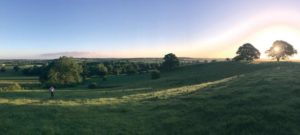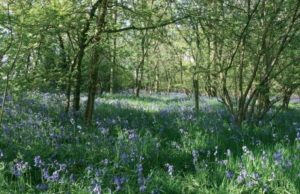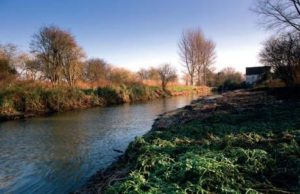Dedham Vale AONB and Stour Valley Project

As the leading person working for the Dedham Vale Area of Outstanding Natural Beauty (AONB) and Stour Valley Project, I am often asked my view on the state of the countryside. This is an interesting question, and the response will often revolve around Brexit, findings from the State of Nature report published at the end of 2016, or development applications for housing, infrastructure or utilities.
These issues are often complicated and interlinked. The view from your window, or the landscapes that are enjoyed (or otherwise) when walking, riding or indeed driving through the Stour Valley are ultimately a reflection of the society we have created.
With Brexit we will see a change to agri-environment support, which, following some transitional arrangements, will ultimately influence the countryside. The wildlife contained within the landscape, (and it is worth noting the State of Nature report suggested that over 50% of our recorded species is in decline), will thrive or otherwise due to decisions made by us. Development decisions, whether they be for new housing, commercial activity or the utilities that we rely on, will influence the way the land is worked, and for many people how it is enjoyed. It is worth noting that the Dedham Vale AONB and Stour Valley project team commissioned a study into the value of tourism in the area, which showed that as a business it was worth nearly £100M pa and supported nearly 2,500 jobs.
 So, the countryside is changing. However, the countryside has always changed, and we have it in our power to influence that change. Through democratic processes we can vote for politicians that implement policy closest to our own individual aspirations. We at the Project have been working on many ways to conserve and enhance the natural beauty of the Stour Valley. These include A River Stour Enhancement Project in partnership with the Environment Agency and supported by the Essex and Suffolk Water Branch Out Fund. This project includes work to remove non-native invasive plant species, such as Himalayan Balsam, and the potentially dangerous Giant Hogweed, from the area. These species often outcompete native species and can create monocultures, thus reducing diversity for both plant and subsequently animal species. The enhancement project is also midway through a project to plant 1,000 trees along the Stour and its tributaries. As well as creating landscape enhancements, the trees provide valuable shade to keep water temperatures suitable for aquatic species, and habitat for species such as invertebrates.
So, the countryside is changing. However, the countryside has always changed, and we have it in our power to influence that change. Through democratic processes we can vote for politicians that implement policy closest to our own individual aspirations. We at the Project have been working on many ways to conserve and enhance the natural beauty of the Stour Valley. These include A River Stour Enhancement Project in partnership with the Environment Agency and supported by the Essex and Suffolk Water Branch Out Fund. This project includes work to remove non-native invasive plant species, such as Himalayan Balsam, and the potentially dangerous Giant Hogweed, from the area. These species often outcompete native species and can create monocultures, thus reducing diversity for both plant and subsequently animal species. The enhancement project is also midway through a project to plant 1,000 trees along the Stour and its tributaries. As well as creating landscape enhancements, the trees provide valuable shade to keep water temperatures suitable for aquatic species, and habitat for species such as invertebrates.
 This project has also been responsible for creating ways to renaturalise the Stour and its tributaries. By creating pools and riffles, baffles and flow deflectors, the works support important micro habitats and improve the chemical composition of the river, as well as providing benefits for humans through enhancement of the visual and audible experience when in the countryside. Each scheme is carefully planned to ensure that it does not contribute to any increased flood risk.
This project has also been responsible for creating ways to renaturalise the Stour and its tributaries. By creating pools and riffles, baffles and flow deflectors, the works support important micro habitats and improve the chemical composition of the river, as well as providing benefits for humans through enhancement of the visual and audible experience when in the countryside. Each scheme is carefully planned to ensure that it does not contribute to any increased flood risk.
The team is rightly proud of the work it does to support volunteer activity. The Stour Valley Volunteers have been undertaking outstanding work throughout the Stour valley: tree planting, creation of wheelchair and pushchair accessible paths, management of rare meadows and many other projects that support the natural beauty of the area. The team also support a number of other volunteering opportunities, such as youth rangers, Constable Country rangers, footpath wardens, and support for events, such as the annual Dedham Vale/Stour Valley Forum.
 We were delighted that at this year’s Forum with the attendance of the Government minister responsible for AONBs, Lord Gardiner; the Chief Executive of the National Association for AONBs, Howard Davies; and the Vice Chancellor of the University of Essex, Professor Jules Pretty OBE. The event was kindly hosted by the Chairman of the Dedham Vale AONB and Stour Valley Partnership, Robert Erith TD DL, at Shrubs Farm, Lamarsh. Lively discussion followed the informative presentations and you can read about the proceedings on the project website. This popular event will return in 2018. Book your place now.
We were delighted that at this year’s Forum with the attendance of the Government minister responsible for AONBs, Lord Gardiner; the Chief Executive of the National Association for AONBs, Howard Davies; and the Vice Chancellor of the University of Essex, Professor Jules Pretty OBE. The event was kindly hosted by the Chairman of the Dedham Vale AONB and Stour Valley Partnership, Robert Erith TD DL, at Shrubs Farm, Lamarsh. Lively discussion followed the informative presentations and you can read about the proceedings on the project website. This popular event will return in 2018. Book your place now.
Of great interest to many people in the Stour Valley is the issue of the AONB boundary review. Many people will know that the Dedham Vale AONB and Stour Valley Partnership informed DEFRA of its aspiration for a boundary review in 2009. The boundary review process is a detailed and involved one that befits the national designation. The chairmen of the partnership and its associated advisory committee wrote to DEFRA in September 2017 with a discussion paper on how the boundary review process might be speeded up. It is understood that the Natural England board have asked for a paper on how the process might be quickened, for its meeting in January 2018. We know that the AONB designation can bring benefits to an area’s tourism economy, as well as ensuring some of England’s finest landscapes are conserved and enhanced for future generations.
At the moment, the Stour Valley is subject to a multitude of development applications. We in the Dedham Vale AONB and Stour Valley team have never sought to stop development, but seek to influence the development so that it does not damage the outstanding landscape of the Stour Valley. The team has been reorganised to support a dedicated Planning Officer, bringing it in line with many AONBs in the south east. We have also recently commissioned a piece of work on the use of colour in design, to support developers to use colours in their developments that will fit with the natural colour palette of the area.

Old Bures Dragon
We will continue to support the farming and business communities that help shape the Stour Valley and make it what a fantastic place it is to live and work. In 2017, the team organised a non-stop 26 hour walk along the Stour Valley Path that runs from Newmarket to Flatford. Although exhausting, the rewards of seeing the Stour Valley landscape, its wildlife and people, were more than enough to make up for some sore feet and tired legs. All those that completed the challenge came away with a sense of what an outstanding place the Stour Valley is.
I started by outlining the question I am often asked. What is the state of the countryside? The countryside does need attention. We understand that there is serious wildlife decline. There are issues with affordability in housing. There are concerns over agricultural change brought about by changes triggered by Brexit, but as I have outlined above, the countryside has always changed, and we need to work together to ensure that it continues to be an outstanding place. The countryside is now perhaps more than ever a place that can deliver multiple benefits: food production, wildlife habitat, a place to live, a place to conduct business and a place to visit. If we work together and plan carefully, perhaps we can have our cake and eat it in the countryside.
Simon Amstutz
Simon has been a regular contributor to the Magazine and he is the leader of the Project.
